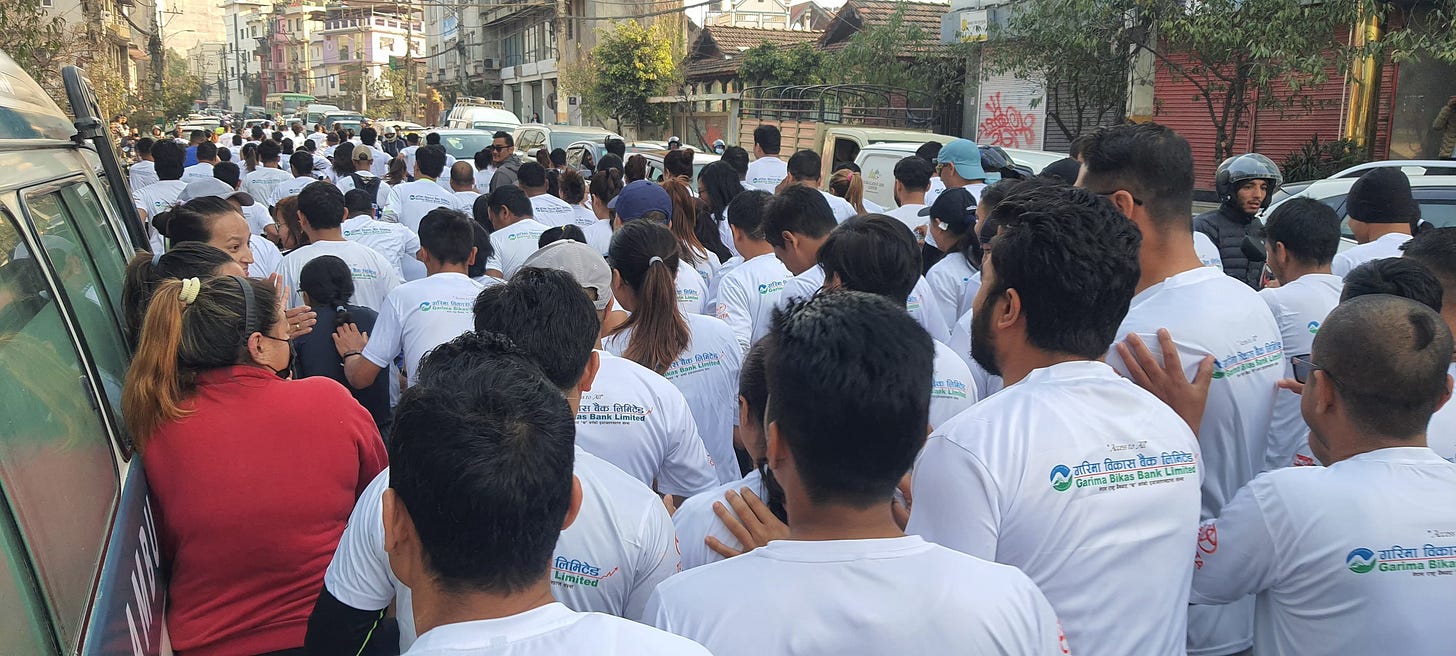RACING TOWRDS BETTER STANDARDS - A CALL FOR SMARTER MARATHON MANAGEMENT IN NEPAL
Standardizing Urban and Trail Runs for a Better Experience and Brand Value

The Current State of Trail Races in Nepal
As a keen observer of how marathons are organized in Nepal, my experience has been deeply rooted in trail running. Most of my ultramarathons and short-distance runs take place in elevated terrains, such as national park trails around the Kathmandu Valley. In these events, the organizers are typically seasoned trail-running experts who prioritize participant well-being and racer satisfaction. They have established a workable model with basic essentials like strategically placed checkpoints, nutrition availability, and medical support.
However, this "workable" model still has significant potential for improvement. By aligning more closely with international standards, Nepal’s trail races can elevate the experience for runners and attract a broader audience.
Urban Races: A Different Beast
On the other hand, road races in urban environments, like the Kathmandu Marathon and Army COAS Run, bring a different set of challenges. While these events are equally popular, they require heightened precautions to minimize accidents and mishaps. Today’s Garima Bikes Bank race, for instance, made me reflect on both the logistical management and broader implications of organizing urban races.
The event’s shortcomings highlighted the importance of understanding what went wrong, and why. For the sake of Nepal's running community, we must analyze these lapses to advocate for better standards in future races.
The Roads and Runners: A Disconnect
One of the biggest issues in today’s race was the lack of control over the roads. Runners deserve to feel like kings of the road during a marathon, with cleared streets and a safe environment. However, there was a glaring disconnect between race organizers, traffic control, and the public.
For instance, vehicular movement continued right up to the race’s start, leading to confusion. The delay was compounded by prolonged ceremonies and chaotic coordination, prompting frustrated drivers to force their way through the supposed "no-vehicle" zone. Even with police intervention, traffic resumed mid-event, disrupting the runners’ experience.
This raises important questions: Were these delays due to procedural inefficiencies, cultural tendencies, or a lack of proactive planning? Whatever the reason, such chaos undermines the essence of a road race.

Logistics and Participant Experience
Another glaring issue was the disorganized management of participants and logistics. Urban races attract large crowds, yet today’s event lacked basic direction. There were no clear signs for start points, restrooms, or baggage areas. Participants were left to navigate an overcrowded space with no guidance, leaving many frustrated even before the race began.
Equally troubling was the lack of hospitality. Runners were not treated as valued guests but as mere members of the crowd. Basic elements like race briefings, itineraries, and volunteer support were conspicuously absent. For a financial institution sponsoring the event, such mismanagement reflects poorly on their brand. If marathons are intended to build brand value, they must be organized with care and precision.
Outsourcing: A Solution to the Chaos
Today’s race highlighted a compelling idea: Why not outsource race management to experienced professionals? A well-organized race could enhance brand value, improve participant experiences, and minimize logistical disasters.
Outsourcing offers three core benefits: valuing time, valuing participation, and valuing community. By partnering with race management experts, sponsors can focus on their branding goals while leaving the execution to those with the necessary expertise. This approach ensures proper planning, resource optimization, and a smoother race-day experience.
The Business of Better Races
A successful marathon management organization would need to focus on governance, technology, business development, and marketing. By outsourcing races to such entities, sponsors can ensure seamless execution while achieving their branding objectives.
For example, a financial institution could sign a long-term agreement with a race organizer, integrating the event into their CSR initiatives. This model allows sponsors to retain control over branding while relying on professionals to handle logistics, safety, and participant engagement. It’s a win-win scenario for all stakeholders.
Rethinking Urban Race Management
Urban races require meticulous planning to avoid chaos. Today’s event, with its disorganized start and overcrowded conditions, could have been a much different experience with better management. To create meaningful brand value through outdoor events, companies must embrace outsourcing and establish races as integral to their corporate values.
Moreover, races should go beyond cash prizes. Highlighting and branding top performers can open new avenues for business and elevate the sport’s status in Nepal.
Should Races Have Registration Fees?
Lastly, I wondered if today’s chaos was partly due to the absence of registration fees. Would the event have been better organized if participants paid to register? Perhaps. A reasonable fee might ensure greater accountability and allow organizers to allocate more resources for better management.
So, would I pay for a better race experience? Absolutely. And I believe many others would too.
Conclusion
The potential for road and trail races in Nepal is immense, but achieving world-class standards requires a shift in mindset. By addressing logistical shortcomings, embracing outsourcing, and valuing participants, Nepal can transform its racing culture into one that runners and sponsors alike can be proud of. It’s time for a new chapter in Nepal’s marathon journey—one where chaos is replaced with coordination, and races truly reflect the spirit of the sport.
Bishal is a Chartered Accountant passionate about numbers and trails.
Based on my Strava activity titled "GARIMA BIKASH BANK OPEN MARATHON," I completed a 5 km run in 22 minutes and 25 seconds, averaging a pace of approximately 4 minutes and 29 seconds per kilometer.
https://www.strava.com/activities/12961921557
Media coverage -
https://www.bizshala.com/article/9389?fbclid=IwY2xjawGuuhVleHRuA2FlbQIxMQABHTHk9dpIx1-L9suIpZ7vTfzQYMFQcfanH0lisM_Egh1IgZSlENpOv1igPw_aem_21M_QPJw-JXq10pi2Hy34Q
https://www.facebook.com/garimabank





